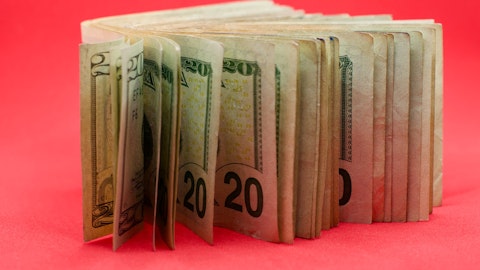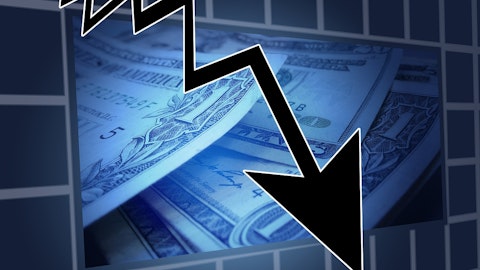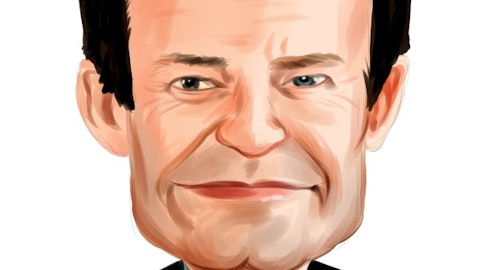Richard Tobin: Yes, we’ve been pretty disciplined in terms of not repricing our backlog. For sure. So I don’t expect any issues there that are not manageable. I think that what we can expect at the beginning of this year is everybody having a view — we’re not and this includes us when we deal with our own suppliers that inflation is coming down. And if I, if I spend some time in Q1 renegotiating maybe I can force the issue to a certain extent. So in our estimates, we don’t have any unannounced pricing that’s not out in the marketplace, meaning that’s not baked into our numbers, another price increase in the June time period. But it’s going to be it’s, it’s going to be interesting to see how it develops over time. I think it’s going to be reflected more in a delay in terms of the order rates, until we get into a position of back and forth of do you — when do you need the product and when do you have to stop negotiating the price?
Jeff Sprague: And that algorithm leaves your price cost positive for the year as it stands?
Richard Tobin: Yes. Yes. Our estimates are price cost positive for the year based on roll forward, what basically what you see in Q4.
Jeff Sprague: Right, thank you.
Richard Tobin: You’re welcome.
Operator: Our next question comes from Steve Tusa from JPMorgan.
Steve Tusa: Hey, guys, good morning.
Richard Tobin: Good morning.
Steve Tusa: So it just if you have these backlogs, right, and expect them to expect to work them down over the course of the year. Why wouldn’t that mean that, assuming that those lead times I mean, they are extended, but I wouldn’t think too extended given the nature of your business. Why wouldn’t that, liquidation of backlog help kind of the normal seasonality, assuming that you — your the trend line is what it is, but you’re delivering at a backlog which should help sales in the near term. Why are customers not taking this stuff earlier?
Richard Tobin: Well, a lot of them are based on their own CapEx plan. So as we as we talked about in the end of Q4 about the decline in dispensers it was kind of interesting to us because we were shipping heavily in the below ground and hardly shipping anything and above ground. And that was a reflection of the delay in getting these projects done because of supply chain constraints and labor and everything else. I think that we’re going to see a little, that’s an example. We’re going to see a little bit of that more in Q1. Right? So despite having the backlog, the customers are not saying, what, deliver it on January 1, and I’ll go put it in the warehouse, and I’ll pull it out when I want. They just don’t feel the need. That’s what was kind of going on in the marketplace to a certain extent, for a period of time.
As that accordion effect is beginning to unwind. Yes, the backlog is there, but they’re saying, what, here’s the timing of my project, and I may want it in March. I may want it in April. So the depletion will be orderly over the balance of the year.
Steve Tusa: Got it. And then how much price are you, are you assuming this year in the organic?
Richard Tobin: I don’t think that we disclose that, but it’s a good portion of the organic growth is price.
Steve Tusa: Okay, and then one last one for you just on orders. I think to get to that level of backlog at the end of the year looks like it’s roughly I don’t know, like a $2 billion backlog assuming a mid-single digit growth rate, which would imply roughly 6 billion of orders. Is that does that feel about right?
Richard Tobin: Let me do it in my head. Yes, that’s, that’s close. Yes.
Steve Tusa: Okay. And
Richard Tobin: It gets very much it’s going to be very much contingent of what happens in the long cycle portion of the business, right? The Maags and the Belvac and to a certain extent, SWEP, which is becoming a long-cycle business, because we’re beginning to rather than sell the products and selling capacity. So if those three hang in there, then yes, that’s what that’s all be.
Steve Tusa: Yes. Okay. That, and those would be the toughest comps in the first half.
Richard Tobin: Correct.
Steve Tusa: Yes. Okay. Great. Thanks.
Richard Tobin: Thanks.
Operator: The next question comes from Joe Ritchie from Goldman Sachs.
Joe Ritchie: Thanks. Good morning, guys.
Richard Tobin: Hey Joe.
Joe Ritchie: So, Rich I just want to make sure I understand your seasonality comments as it relates to the first quarter. Because if I go back to like prior seasonality, you could see, the first quarter being kind of like a high teens percentage of the full year to kind of mid 20s. I mean, if I use the midpoint, it kind of puts me around the $2 range. If I’m doing the math, right. For the first quarter, I just want to make sure that I’m level setting correctly.





